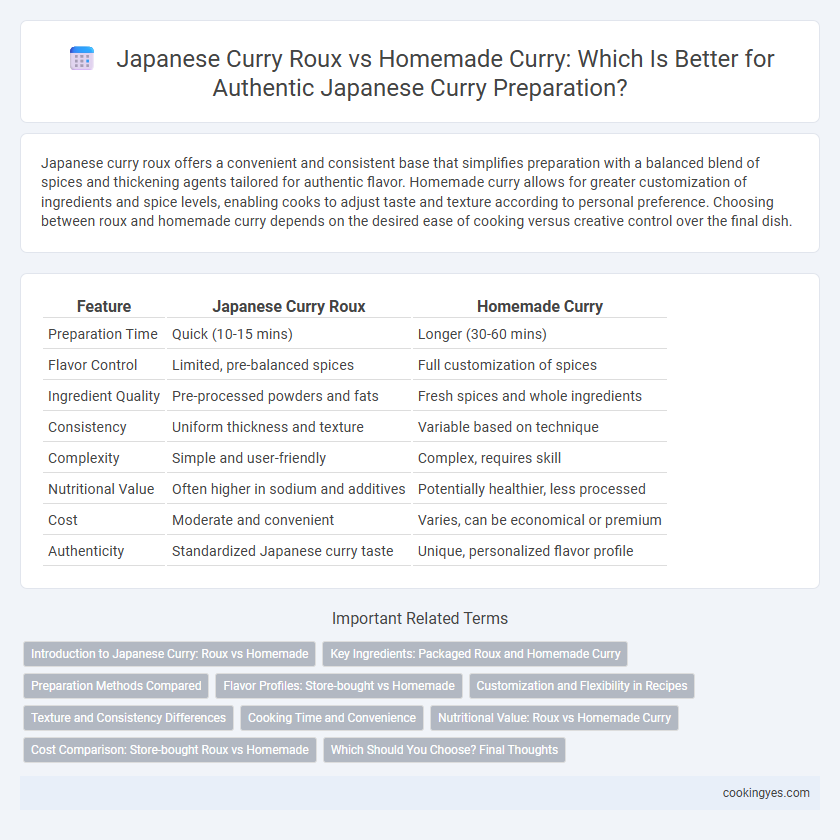Japanese curry roux offers a convenient and consistent base that simplifies preparation with a balanced blend of spices and thickening agents tailored for authentic flavor. Homemade curry allows for greater customization of ingredients and spice levels, enabling cooks to adjust taste and texture according to personal preference. Choosing between roux and homemade curry depends on the desired ease of cooking versus creative control over the final dish.
Table of Comparison
| Feature | Japanese Curry Roux | Homemade Curry |
|---|---|---|
| Preparation Time | Quick (10-15 mins) | Longer (30-60 mins) |
| Flavor Control | Limited, pre-balanced spices | Full customization of spices |
| Ingredient Quality | Pre-processed powders and fats | Fresh spices and whole ingredients |
| Consistency | Uniform thickness and texture | Variable based on technique |
| Complexity | Simple and user-friendly | Complex, requires skill |
| Nutritional Value | Often higher in sodium and additives | Potentially healthier, less processed |
| Cost | Moderate and convenient | Varies, can be economical or premium |
| Authenticity | Standardized Japanese curry taste | Unique, personalized flavor profile |
Introduction to Japanese Curry: Roux vs Homemade
Japanese curry preparation involves choosing between store-bought roux and homemade curry base, each offering distinct flavors and convenience. Curry roux provides a quick, consistent taste with a blend of spices and thickening agents, ideal for busy households seeking authentic flavor. Homemade curry allows customization of spice levels and ingredients, delivering a fresher, more personalized dish adapted to individual preferences.
Key Ingredients: Packaged Roux and Homemade Curry
Japanese curry roux offers a convenient blend of pre-mixed spices, thickening agents, and flavor enhancers like caramelized onion powder, resulting in consistent taste and texture with minimal effort. Homemade curry allows precise control over key ingredients such as fresh spices, coconut milk, and vegetables, enabling customization to individual preferences and dietary needs. While packaged roux emphasizes speed and uniformity, homemade curry prioritizes ingredient quality and flavor complexity in Japanese curry preparation.
Preparation Methods Compared
Japanese curry roux offers a convenient and consistent preparation method, containing a blend of pre-measured spices, flour, and fats that simplifies the cooking process and reduces preparation time. Homemade curry requires simmering a mixture of fresh spices, vegetables, and proteins, allowing for customized flavor profiles and control over ingredient quality. The roux method enhances ease and speed, while homemade curry emphasizes depth of flavor and ingredient flexibility.
Flavor Profiles: Store-bought vs Homemade
Japanese curry roux offers a consistent balance of savory, sweet, and umami flavors with a convenient blend of spices and thickening agents, ideal for quick preparation. Homemade curry allows for personalized flavor adjustments using fresh ingredients like grated apples, soy sauce, and various spices, resulting in a more complex and layered taste. The choice between store-bought and homemade curry roux significantly impacts the depth and richness of the final Japanese curry dish.
Customization and Flexibility in Recipes
Japanese curry roux offers a convenient base with consistent flavor and texture, enabling quick preparation while limiting customization due to pre-mixed spices and thickening agents. Homemade curry allows complete control over ingredient selection and seasoning balance, catering to dietary preferences and personalized spice levels for a tailored taste experience. The flexibility of homemade curry supports experimentation with fresh vegetables, proteins, and unique spice blends, enhancing nutritional value and depth of flavor beyond the standardized roux options.
Texture and Consistency Differences
Japanese curry roux provides a thick, smooth texture with consistent viscosity due to its pre-formulated mix of flour, fat, and spices, ensuring a uniform curry base every time. Homemade curry allows for greater control over texture by adjusting ingredients like flour, butter, and stock, resulting in a customizable consistency that can range from creamy to chunky. The roux method typically yields a richer, gel-like body, while homemade curry can offer varied textures reflecting personal preference and freshness of ingredients.
Cooking Time and Convenience
Japanese curry roux significantly reduces cooking time by offering a ready-made blend of spices and thickening agents, enabling a convenient and quick preparation process within 30 minutes. Homemade curry requires a longer cooking time, typically over an hour, as it involves sourcing individual spices, sauteing, and simmering to develop deep flavors. For busy cooks, roux provides unmatched convenience without compromising the signature rich and savory taste of Japanese curry.
Nutritional Value: Roux vs Homemade Curry
Japanese curry roux often contains higher levels of sodium, saturated fats, and preservatives compared to homemade curry, which typically uses fresh ingredients with controlled oil and salt content. Homemade curry allows for greater nutritional customization, enabling the inclusion of more vegetables, lean proteins, and whole spices that boost fiber, vitamins, and antioxidants. The controlled preparation in homemade curry generally results in a healthier nutrient profile with less processed additives and lower calorie density.
Cost Comparison: Store-bought Roux vs Homemade
Store-bought Japanese curry roux offers convenience and consistency at an average cost of $3 to $5 per block, making it an economical choice for quick meal preparation. Homemade curry roux, consisting of individual ingredients like flour, butter, curry powder, and spices, can reduce overall expenses to around $1 to $2 per serving when purchased in bulk, enhancing cost efficiency for frequent cooks. Evaluating long-term savings, homemade roux provides better value through customization and ingredient control despite initial preparation time.
Which Should You Choose? Final Thoughts
Japanese curry roux offers convenience with its balanced blend of spices and consistent flavor, making it ideal for quick and reliable curry preparation. Homemade curry allows for creative control over ingredients, spice levels, and thickness, resulting in a personalized taste that can highlight fresh vegetables and meats. When choosing between the two, consider your time constraints and flavor preferences to decide whether ease or customization is your priority.
Japanese Curry Roux vs Homemade Curry for Japanese curry preparation Infographic

 cookingyes.com
cookingyes.com